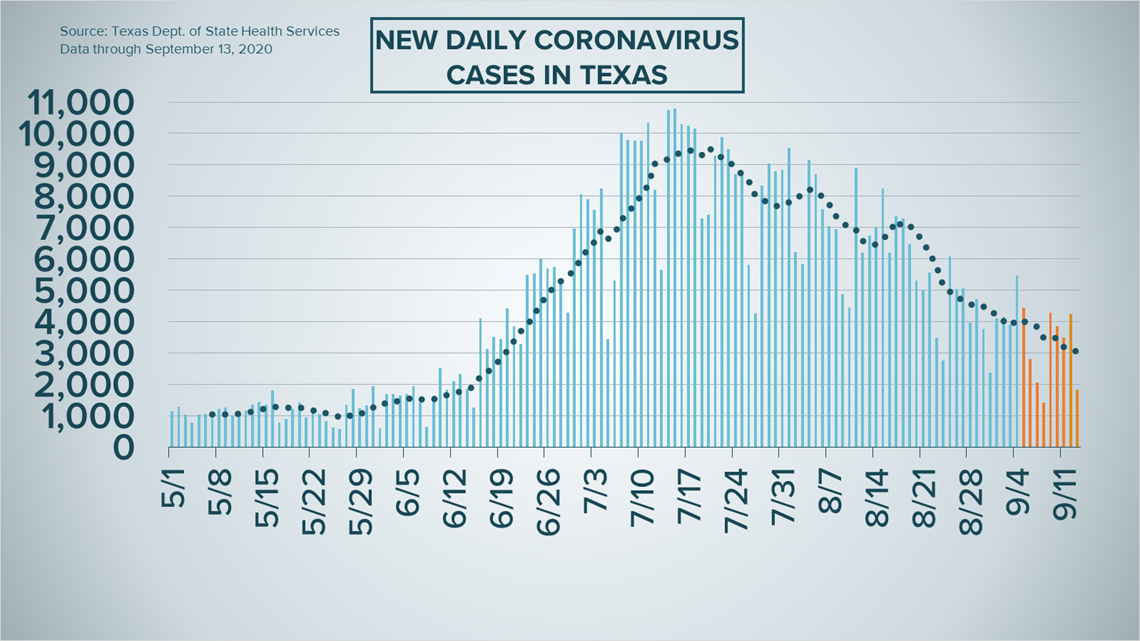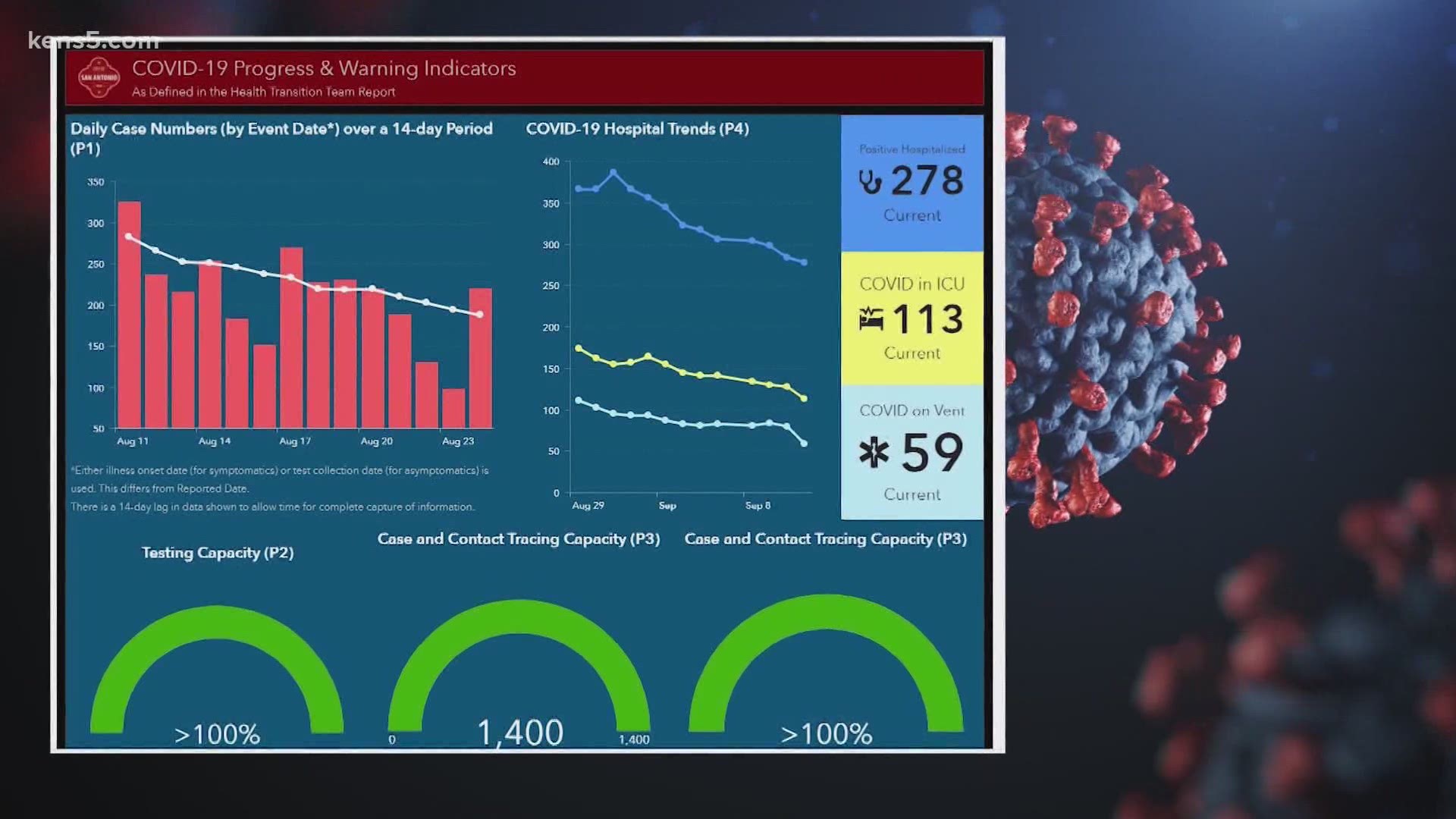SAN ANTONIO — We're tracking the latest numbers from the coronavirus pandemic in San Antonio and across Texas. Here are the latest numbers reported by Bexar and surrounding counties:
- Bexar County: 142 new cases were reported Sunday, bringing the total number for the county to (48,198). The county death toll, meanwhile, rose to 1,016 after 24 fatalities were reported.
- Comal County: The county reported 12 additional cases and no additional deaths Friday. There have been a total of 3,140 cases of COVID-19 in the county – including 2,495 confirmed cases – while 114 county residents have died. County officials say there are 320 active coronavirus cases, and 2,706 residents are considered recovered.
- Hays County: Officials in Hays County on Friday reported 30 new cases in the county and no additional virus-related deaths. As of Friday, there are a total of 5,598 lab-confirmed cases in the county (1,914 of which are active) while the death toll stands at 51. 3,602 are considered recovered.
How Bexar County is trending
We've tracked how many coronavirus cases have been confirmed in Bexar County from the time officials began reporting cases in March 2020. The graphic below shows the number of cases since June and charts those daily case numbers along a 7-day moving average to provide a more accurate picture of the overall coronavirus case curve in our area and the direction we're trending amid the pandemic.
On Sunday, Metro Health updated its online coronavirus surveillance dashboards to report 142 additional cases in Bexar County and a total case count of 49,915. The total number on Saturday was 48,198, and the discrepancy of 1,575 cases was attributed by officials to a backlog in cases.
The below graph does not include the backlog of cases.


Over 1,000 people have died in the county after 24 additional virus-related fatalities were reported. One was new, while 23 occurred between June and August. In all, 1,016 Bexar County residents have died from COVID-19 complications. DSHS has reported 1,200, and 184 remain under investigation.
Metro Health also reported new hospitalization figures that continue downward trends. 246 Bexar County residents were receiving treatment for coronavirus symptoms on Sunday, down from 260 on Saturday. The number of patients using a ventilator (54) and in intensive care (108) also went down slightly.
Coronavirus in Texas
The Texas Department of State Health Services on Sunday reported an additional 1,840 new coronavirus cases, raising the total to 659,434. Five older cases were included in the statewide total but not in the new daily cases.


Meanwhile, the state also reported an additional 47 coronavirus-related deaths on Sunday, raising the death toll to 14,190.
An estimated 577,832 Texans have recovered from the coronavirus, while the state estimates 67,412 cases remain active. The number of patients currently in Texas hospitals dropped by 52 to 3,319 on Sunday.
As the school year begins to get underway for local districts, we are also keeping track of the most important updates for each, including links to dashboards created to track coronavirus cases.
Latest Coronavirus Headlines
- As Trump played down virus, health experts' alarm grew
- Domesticas Unidas assists San Antonians with employment and financial relief during coronavirus pandemic
- University of Texas at Austin tailgaters find a way around the no-tailgating rule
- New study finds dining out increases chances of catching coronavirus
- More than 800 nurses begin strike at Chicago hospital
- New UTSA class explores coronavirus pandemic through a different lens
Coronavirus symptoms
The symptoms of coronavirus can be similar to the flu or a bad cold. Symptoms include fever or chills, cough, shortness of breath or difficulty breathing, fatigue, muscle or body aches, headache, new loss of taste or smell sore throat, congestion or runny nose, nausea or vomiting and diarrhea, according to the Centers for Disease Control.
Most healthy people will have mild symptoms. A study of more than 72,000 patients by the Centers for Disease Control in China showed 80 percent of the cases there were mild.
But infections can cause pneumonia, severe acute respiratory syndrome, kidney failure, and even death, according to the World Health Organization. Older people with underlying health conditions are most at risk.
But infections can cause pneumonia, severe acute respiratory syndrome, kidney failure, and even death, according to the World Health Organization. Older people with underlying health conditions are most at risk.
Experts determined there was consistent evidence these conditions increase a person's risk, regardless of age:
- Chronic kidney disease
- COPD (chronic obstructive pulmonary disease)
- Obesity (BMI of 30 or higher)
- Immunocompromised state (weakened immune system) from solid organ transplant
- Serious heart conditions, such as heart failure, coronary artery disease, or cardiomyopathies
- Sickle cell disease
- Type 2 diabetes
The CDC believes symptoms may appear anywhere from two to 14 days after being exposed.
Human coronaviruses are usually spread...
- Between people who are in close contact with one another (within about 6 feet).
- Through respiratory droplets produced when an infected person coughs, sneezes or talks. These droplets can land in the mouths or noses of people who are nearby or possibly be inhaled into the lungs.
- Some recent studies have suggested that COVID-19 may be spread by people who are not showing symptoms.
Help stop the spread of coronavirus
- Stay home when you are sick.
- Eat and sleep separately from your family members
- Use different utensils and dishes
- Cover your cough or sneeze with your arm, not your hand.
- If you use a tissue, throw it in the trash.

